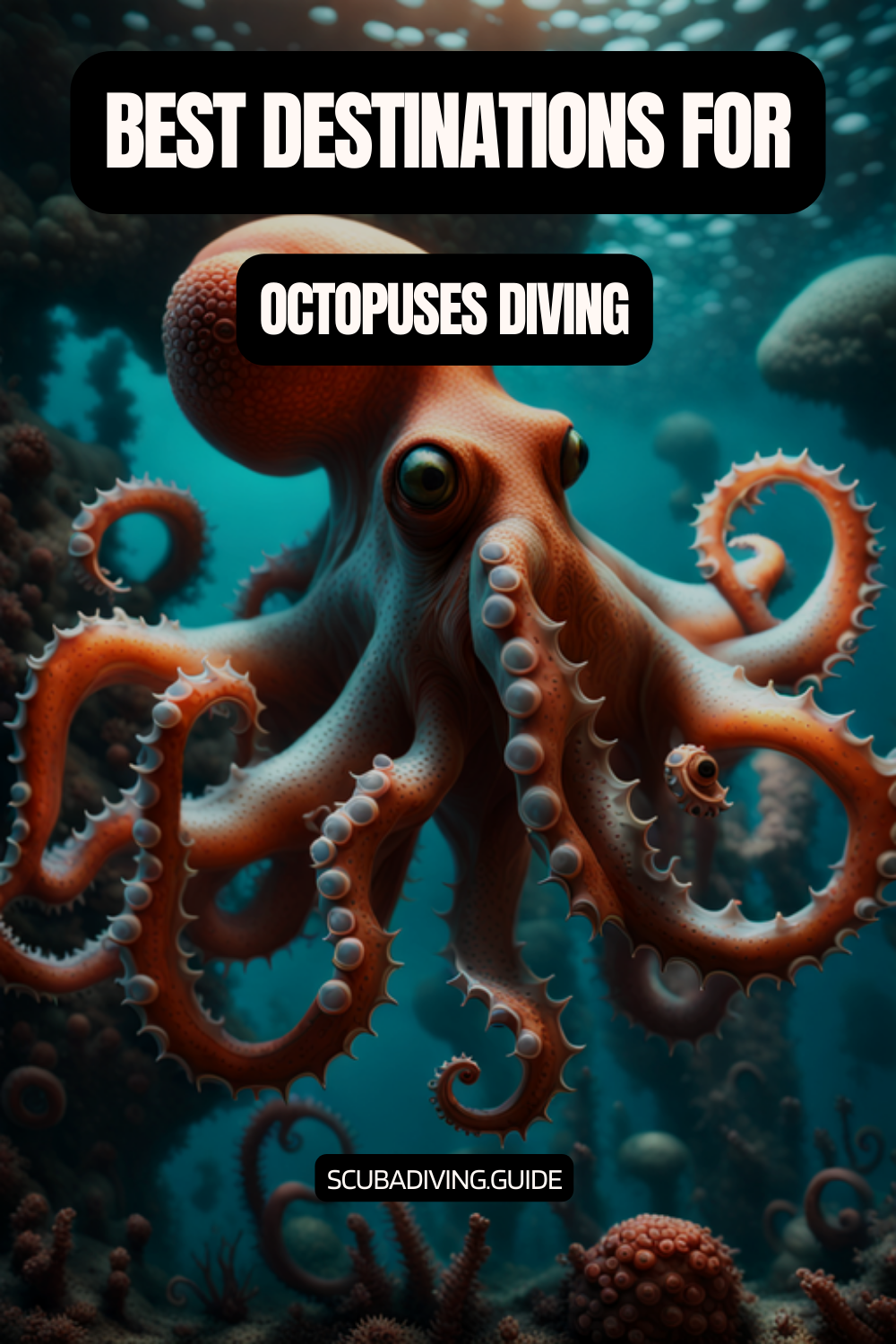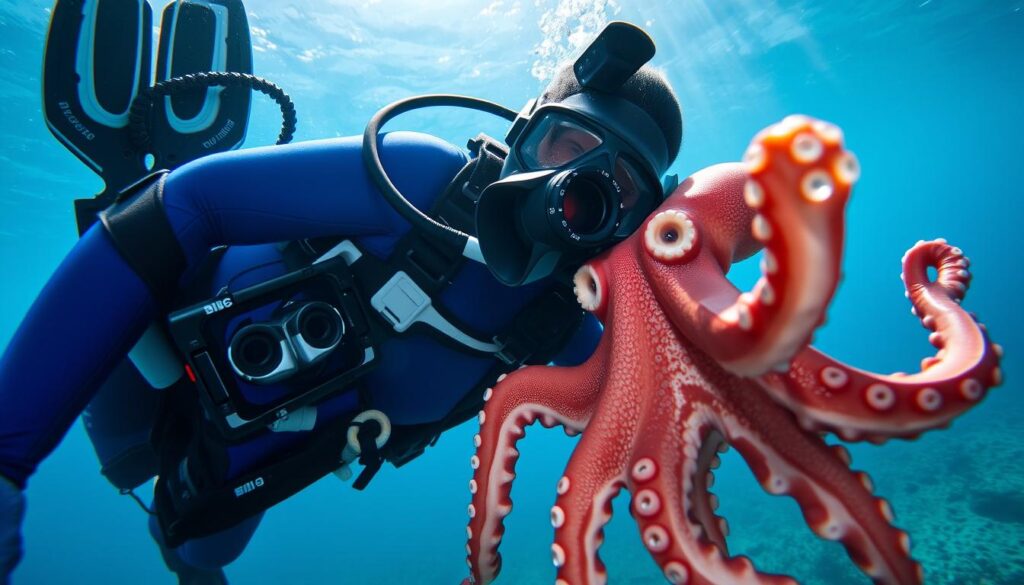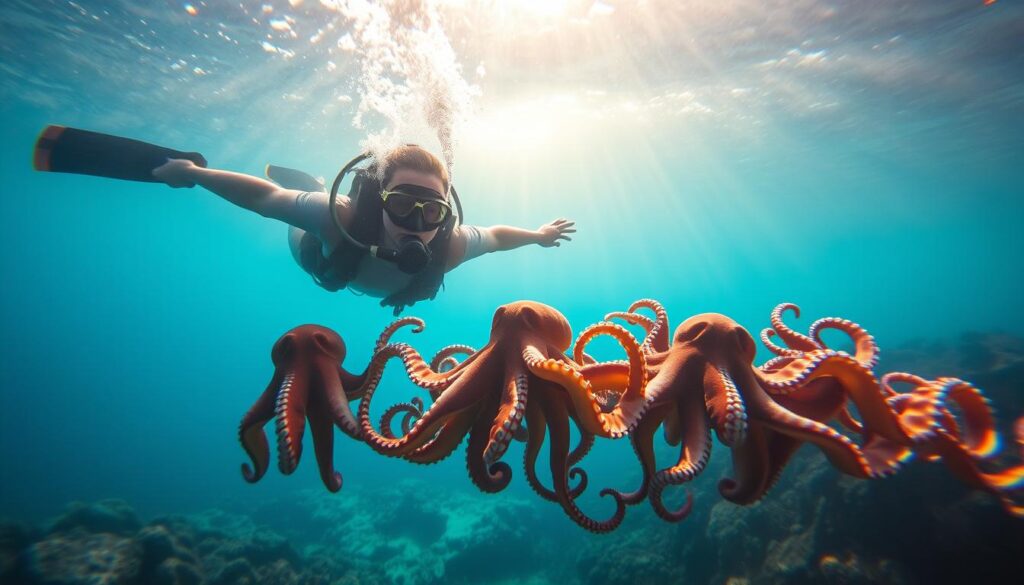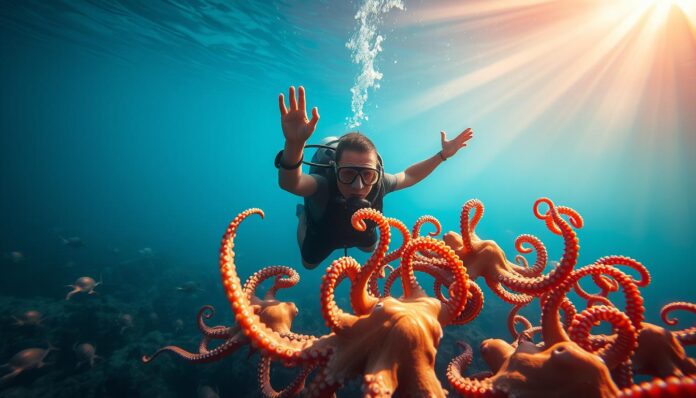Imagine diving into a world where creatures older than dinosaurs roam. Octopuses, which first appeared on Earth around 300 million years ago, are a key part of this underwater world. They offer a unique sea life exploration experience for divers.
Scuba diving with octopuses is an extraordinary adventure. It connects humans with some of the ocean’s most intelligent creatures. These remarkable beings have survived countless challenges, developing incredible adaptations.
From the tiny blue-ringed octopus to the massive giant Pacific octopus, these cephalopods are a breathtaking sight. Their ability to change colors, solve complex problems, and navigate underwater terrain makes diving with them an unforgettable experience.
Key Takeaways – Diving with Octopuses
- Octopuses have existed for over 300 million years
- Approximately 300 different octopus species exist worldwide
- Octopuses demonstrate remarkable intelligence and adaptability
- Each dive offers a unique encounter with these marine creatures
- Scuba diving with octopuses provides an unmatched underwater adventure
Introduction to Scuba Diving with Octopuses
Exploring the underwater world is full of mysteries. Cephalopod encounters are among the most exciting for those who dive. They show us the amazing lives of one of the ocean’s smartest creatures.
Octopuses are a mix of biological wonder and complex marine ecosystems. They have unique traits that make them stand out in the underwater world.
What Makes Octopuses Unique?
Octopuses are truly remarkable with features that make them different from other sea creatures:
- Three hearts that pump blue blood through their bodies
- Ability to regenerate lost limbs
- Advanced nervous system with sophisticated problem-solving skills
- Expert camouflage capabilities
The Fascination of Encountering Octopuses
During marine biology adventures, divers are amazed by octopuses’ incredible abilities. They can change color and texture in seconds, creating a unique underwater show.
| Octopus Species | Max Depth | Arm Span |
|---|---|---|
| Two Spot Octopus | 165 feet | 24 inches |
| Red Octopus | 700 feet | 16 inches |
| Giant Pacific Octopus | 330 feet | 30 feet |
“Every cephalopod encounter is a window into an alien world of intelligence and adaptability.”
Learning about these incredible creatures turns a simple dive into a deep exploration of marine life’s complexity and beauty.
Top Destinations for Scuba Diving with Octopuses
Scuba diving spots for octopus sightings are amazing for marine lovers. You can find them in tropical reefs and temperate waters. These places offer unforgettable dives for all skill levels.
The world has incredible places for snorkeling with octopuses. Here are some top spots for amazing octopus encounters.
Global Hotspots for Octopus Encounters
Diving with octopuses is an exciting adventure that can be experienced in various parts of the world. From the vibrant reefs of the Caribbean to the rich marine ecosystems of Asia, here is a list of some of the best destinations for diving with octopuses, separated by regions:
Asia:
- Indonesia: Known for its exceptional marine biodiversity, Indonesia offers fantastic opportunities to dive with octopuses. Locations such as Bali, Komodo National Park, and the Lembeh Strait in North Sulawesi are renowned for their vibrant underwater ecosystems and frequent octopus sightings.
- Philippines: With its vast archipelago, the Philippines is a haven for underwater enthusiasts. Destinations like Anilao, Dumaguete, and Puerto Galera are famous for their macro marine life, including a variety of octopus species.
- Maldives: The Maldives is a dream destination for divers, featuring stunning coral reefs and abundant marine life. The Maldives’ clear turquoise waters provide excellent visibility to witness octopuses in their natural habitats.
- South Africa: South Africa offers diverse diving experiences, including encounters with octopuses. Sodwana Bay, in particular, is known for its diverse marine life, including octopuses, along with opportunities to explore stunning coral reefs.
- Egypt: Egypt’s Red Sea is renowned for its captivating dive sites. Destinations like Dahab, Hurghada, and Marsa Alam boast an array of marine species, including octopuses, against a backdrop of vibrant coral gardens.
Caribbean:
- Bonaire: Located in the Dutch Caribbean, Bonaire is a paradise for divers. Its protected marine parks offer a wealth of marine life, including octopuses. The calm, clear waters of Bonaire allow for excellent visibility and relaxed encounters with these fascinating creatures.
- Cayman Islands: The Cayman Islands are renowned for their spectacular dive sites and diverse marine ecosystems. Locations like Grand Cayman and Little Cayman provide opportunities to encounter octopuses amidst colorful coral reefs and underwater walls.
- Mexico: Mexico’s Yucatan Peninsula, including popular destinations like Cozumel and Tulum, offers incredible diving experiences. The Mesoamerican Barrier Reef System provides a home for a variety of marine life, including octopuses.
- Belize: Belize’s Great Blue Hole and the Belize Barrier Reef Reserve System are UNESCO World Heritage Sites known for their rich biodiversity. Divers can explore these vibrant ecosystems and encounter octopuses amidst an array of marine species.
- Greece: Greece’s islands and coastal regions offer rewarding diving experiences. Locations such as the Ionian Islands, Crete, and the Aegean Sea provide opportunities to observe octopuses in their natural habitats and explore ancient ruins beneath the waves.
- Spain: The Mediterranean coast of Spain offers diverse diving opportunities. Destinations like the Costa Brava, the Balearic Islands, and the Canary Islands provide encounters with octopuses in crystal-clear waters.
- Australia: Australia’s Great Barrier Reef is a world-renowned destination for diving enthusiasts. Locations such as the Whitsunday Islands, Cairns, and the Ningaloo Reef offer stunning underwater landscapes and the chance to witness octopuses in their natural environment.
- Palau: Located in Micronesia, Palau is known for its pristine reefs and abundant marine life. Divers can explore sites like Blue Corner and German Channel, where encounters with octopuses are common.
- California, USA: California’s coastline offers diverse diving opportunities, with the kelp forests of Monterey Bay and Channel Islands National Park being popular locations for encounters with octopuses.
- British Columbia, Canada: British Columbia’s cold-water diving presents unique encounters with the giant Pacific octopus. Locations such as Vancouver Island and the Sunshine Coast offer opportunities to witness these magnificent creatures up close.
- Galapagos Islands, Ecuador: The Galapagos Islands are a bucket-list destination for divers. This remote archipelago is renowned for its unique marine life, and encounters with octopuses are common while exploring the underwater volcanic landscapes.
- Fernando de Noronha, Brazil: Located off the northeastern coast of Brazil, Fernando de Noronha is an ecological sanctuary with pristine marine environments. Divers can enjoy encounters with octopuses amidst vibrant coral reefs and crystal-clear waters.
When planning a dive trip to any of these destinations, be sure to research the local diving regulations, seasons, and dive operators to ensure a safe and memorable experience.

Unique Dive Sites and Octopus Species
Each place offers a chance to see different octopus species. You can see tiny pygmy octopuses or huge Pacific octopuses.
| Location | Octopus Species | Best Diving Season |
|---|---|---|
| Indonesia | Mimic Octopus | April-November |
| Hawaii | Giant Pacific Octopus | Year-round |
| Greece | Common Octopus | May-September |
| Maldives | Coconut Octopus | December-April |
Seasonal Considerations for Diving Trips
When planning dives for octopus sightings, know the seasons. Water temperature, marine life, and local conditions affect octopus sightings.
“The magic of diving with octopuses lies not just in seeing them, but in understanding their incredible adaptability and intelligence.” – Marine Biologist
Research your destination, talk to local dive operators, and get ready for an amazing dive. These dives will show you the incredible world of octopuses.
Preparing for Your Dive
Scuba diving with octopuses needs careful planning and the right gear. Knowing the key equipment and safety steps can make your underwater photos better. It also ensures a great time with these amazing sea creatures.

Essential Diving Gear for Octopus Encounters
Choosing the right gear is key for diving with octopuses. Here’s a list of what you need:
- High-quality mask with clear peripheral vision
- Reliable underwater camera for capturing marine life
- Secondary air source (octopus regulator)
- Wetsuit appropriate for water temperature
- Dive computer with depth and time tracking

Safety Tips for Diving Near Octopuses
When taking photos underwater, safety is top priority with octopuses. Some can be dangerous, like the blue-ringed octopus.
| Safety Consideration | Recommended Action |
|---|---|
| Maintain Safe Distance | Stay at least 3-4 feet away from octopuses |
| Observation Technique | Use slow, non-threatening movements |
| Emergency Preparedness | Carry secondary air source (octopus regulator) |
“Respect the marine environment and its inhabitants. Your safety and the octopus’s well-being depend on careful, considerate interaction.”
The octopus regulator is a vital piece of gear. Its longer hose helps in emergency air-sharing scenarios. It’s built to last, with a purge valve for quick water clearing and reliable performance under stress.
It’s important to keep your diving gear in good shape. Rinse it with fresh water after each dive. Also, have it serviced by professionals as needed to ensure it works well and keeps you safe during your dives.
Understanding Octopus Behavior
Marine biology adventures show us the amazing world of octopus behavior. These creatures are some of the most interesting in the sea. They have incredible abilities that amaze both marine researchers and divers.
Social Behavior: Solitary Creatures with Surprising Interactions
Octopus behavior is unlike anything else in the sea. They are mostly alone but have complex social interactions. This fascinates marine biologists.
- Typically prefer individual habitats
- Can communicate through complex color and texture changes
- Demonstrate individual personality traits
Communication: A Silent Language of Colors and Movements
Octopuses talk to each other in a silent language. They change color and texture for many reasons, not just to hide. This includes showing feelings and what they plan to do.
An octopus can transform its appearance in milliseconds, making it the ultimate master of underwater communication.
| Communication Method | Purpose |
|---|---|
| Color Change | Camouflage, Emotional Expression |
| Body Posture | Threat Display, Mating Signals |
| Texture Manipulation | Predator Deterrence, Environmental Adaptation |
Learning about octopus behavior takes patience and careful watching. These marine biology adventures give divers a special look into the world of octopuses. They show a complex way of communicating that amazes scientists and sea lovers alike.
The Best Time for Octopus Sightings
Timing is key when exploring sea life and diving for octopus sightings. Knowing the best seasons and times to dive can really help you see these amazing creatures.
Seasonal Patterns and Migration
Octopus behavior changes a lot depending on where they are and what kind they are. Here are some important points for divers:
- Most octopus species are most active during certain months
- Tropical areas have more consistent octopus sightings
- Water temperature affects how easy it is to see octopuses
Best Times of Day for Octopus Encounters
Knowing when octopuses are most active is key for great dives. Dawn and dusk are the best times for underwater adventures.
| Location | Best Diving Months | Optimal Time of Day |
|---|---|---|
| Lembeh Strait, Indonesia | October to May | Early morning/Late afternoon |
| Anilao, Philippines | November to May | Twilight hours |
| Riviera Maya, Mexico | November to March | Sunrise and sunset |
“The magic of octopus encounters happens when you sync your dive with their natural rhythms.” – Marine Biologist Research Team
Night dives are great for seeing sea life. Octopuses are more active at night, showing behaviors you won’t see in the day. Divers need good lights and should be careful not to disturb them.
It’s smart to learn about the octopus species in your area. Each place has its own special way of seeing octopuses.
Photography Tips for Capturing Octopus Encounters
Underwater photography is tough when you’re trying to catch cephalopods like octopuses. They are experts at hiding, making them hard to photograph. You need special skills and tools to get their picture.
Getting great underwater photos takes a lot of planning and knowledge. The right steps can turn brief moments into lasting memories of the sea.
Choosing the Right Equipment
Choosing the right gear is key for underwater photography. Here are some must-haves:
- Camera with underwater housing
- Wide-angle lens (10-17mm recommended)
- Powerful strobe lights
- Waterproof camera settings
Techniques for Cephalopod Encounters
Photographing octopuses needs patience and special techniques. Knowing how they act can help you get amazing shots.
| Photography Setting | Recommended Values |
|---|---|
| ISO | 100 |
| Shutter Speed | 1/125 seconds |
| Aperture | F8 |
| Lighting | Strobe at 1/4 power |
“The magic of underwater photography lies in capturing the unexpected moments of marine life.”
Night dives are the best time to see octopuses. Places like the Philippines and Indonesia have lots of cephalopods. Always keep a safe distance and don’t disturb them while you’re taking photos.
Pro tip: Learn to control your buoyancy well. This helps you avoid disturbing the sea and get great octopus photos.
Environmental Considerations
Exploring sea life means we must protect marine ecosystems. Octopus homes are complex underwater places that need our care. Divers and fans of the sea must respect these habitats.
The Importance of Protecting Marine Life
Marine biology shows us why we must save the sea. New studies give us important lessons on keeping the ocean safe:
- Over 50,000 digital images have documented marine interactions
- 73% of marine substrates involve gelatinous plankton ecosystems
- 5% of larger octopus specimens interact with plastic debris
How to Dive Sustainably in Octopus Habitats
Responsible diving is key to keeping the sea healthy. Divers can help by being careful:
- Maintain proper buoyancy control to avoid disturbing marine life
- Refrain from touching or handling marine organisms
- Use environmentally friendly diving equipment
- Practice responsible underwater photography
“Every dive is an opportunity to protect and respect the marine world we explore.”
By diving responsibly, we can help the ocean. Every careful action we take helps keep the sea and its creatures safe.
Common Misconceptions About Octopuses
Exploring the ocean often uncovers surprising facts about octopuses. These creatures challenge many myths, making marine adventures more interesting. Divers and fans get to see their world in a new light.
Myths vs. Facts: What You Should Know
Octopuses have been misunderstood for a long time. Here are some surprising facts that debunk common myths:
- Myth: Octopuses are simple sea creatures
- Fact: They have 100 million to 500 million neurons, showing great intelligence
- Myth: All octopuses are similar
- Fact: There are up to 300 species worldwide, each unique
Understanding Their Intelligence and Adaptability
Octopuses show amazing cognitive skills. They can solve complex problems, use tools, and even remember humans.
“Octopuses are perhaps the most intelligent invertebrates on the planet, capable of learning and adapting in ways that continue to surprise researchers.”
| Octopus Characteristic | Remarkable Fact |
|---|---|
| Neural Complexity | 100-500 million neurons distributed across body |
| Arm Independence | Can move and coordinate arms independently |
| Size Variation | From 2.5 cm (Octopus wolfi) to 9 meters (Giant Pacific) |
| Unique Blood | Blue-colored hemocyanin instead of red hemoglobin |
Learning about octopus behavior changes how we see marine adventures. It shows their amazing adaptability, problem-solving, and complex communication. These traits challenge our views on animal intelligence.
Personal Experiences: Diving Stories with Octopuses
Scuba diving with octopuses is an exciting adventure. These smart creatures turn a simple dive into a memorable journey.

People from all over have shared amazing stories of their octopus encounters. These stories show how unique and smart octopuses are. Every dive with them is different.
Memorable Underwater Moments
- An unexpected camouflage display that left divers in awe
- Playful interactions revealing octopus curiosity
- Witnessing complex hunting behaviors
- Observing rapid color and texture transformations
“The octopus doesn’t just change color—it becomes the environment,” remarked marine photographer Elena Rodriguez.
Lessons from the Deep
Experienced divers have learned a lot from their dives with octopuses:
- Respect marine life’s personal space
- Observe without disturbing natural behaviors
- Understand that each octopus interaction is unique
| Dive Location | Octopus Behavior | Diver’s Reaction |
|---|---|---|
| Cozumel Reef | Camouflage Master | Stunned Amazement |
| Great Barrier Reef | Curious Interaction | Gentle Engagement |
| Mnemba Atoll | Hunting Display | Respectful Observation |
With 80% of the ocean unexplored, every dive is a chance for a unique encounter. These experiences show us the ocean’s secrets and the octopus’s intelligence.
Common Marine Species Found Alongside Octopuses
Diving with octopuses offers the opportunity to encounter not only these incredible cephalopods but also a variety of other marine species that share their habitat. From colorful reef fish to intriguing invertebrates, here are some common marine species you may encounter alongside octopuses during your dives:
- Reef Fish: Octopuses often inhabit coral reefs, where a multitude of reef fish species can be found. These include angelfish, butterflyfish, parrotfish, clownfish, and wrasses. These vibrant and diverse fish add a splash of color to the underwater scenery and create a lively backdrop to your octopus encounters.
- Moray Eels: Slithering among the crevices and rocky outcrops, moray eels are frequently spotted alongside octopuses. With their elongated bodies and menacing jaws, they make for an intriguing sight. Keep a respectful distance, as moray eels can be territorial and may exhibit defensive behavior if provoked.
- Crustaceans: Many species of crabs and lobsters coexist with octopuses in their habitats. From hermit crabs scurrying along the seabed to colorful reef-dwelling crabs and spiny lobsters hiding in crevices, these crustaceans add an element of curiosity to the underwater environment.
- Cuttlefish: Close relatives of octopuses, cuttlefish are often found in similar habitats. These mesmerizing cephalopods boast incredible color-changing abilities and unique body shapes. Observing the interactions between octopuses and cuttlefish can provide fascinating insights into the behavior and communication of these intelligent creatures.
- Sea Stars: In sandy or rocky areas, you may encounter various species of sea stars, also known as starfish. With their distinctive star-shaped bodies and vibrant colors, they create eye-catching displays on the seafloor. Take care not to disturb these delicate creatures, as some species are sensitive to physical contact.
- Sea Urchins: Sea urchins, with their spiky exteriors and intriguing forms, are commonly found alongside octopuses. They play a vital role in maintaining the balance of reef ecosystems. Take caution not to accidentally touch or step on them, as their spines can cause injury.
- Mollusks: Alongside octopuses, you may encounter various mollusk species, including snails, nudibranchs, and bivalves. Nudibranchs, in particular, are known for their vibrant colors and intricate patterns, adding a touch of natural artistry to the underwater landscape.
- Rays and Sharks: In certain dive locations, encounters with rays and sharks are possible while diving with octopuses. These majestic creatures, such as manta rays, eagle rays, or reef sharks, can create unforgettable moments as they gracefully glide through the water. Admire them from a distance and observe their natural behaviors.
- Sponges and Corals: Octopuses often make their homes among sponges or within coral formations. These sessile creatures add structure and texture to the underwater environment, creating a diverse and vibrant ecosystem. Take care to avoid contact with fragile sponges and corals to prevent damage.
Encountering these common marine species alongside octopuses provides a comprehensive understanding of the intricate web of life that exists beneath the waves. Each species plays a unique role in the marine ecosystem, and witnessing their interactions with octopuses adds depth and richness to your underwater experience.
Remember to approach and observe these marine species with care and respect, keeping a safe distance and refraining from touching or disturbing them. By practicing responsible diving, you can contribute to the conservation and preservation of these fascinating creatures and their habitats.
Conclusion: The Magic of Scuba Diving with Octopuses
Scuba diving with octopuses is an amazing journey into the ocean’s depths. These smart creatures offer a unique underwater experience. They show us a world of complexity, from the Caribbean to Sydney’s shores.
The magic of diving with octopuses is their unique behaviors and adaptability. They have three hearts and the biggest brain among invertebrates. This makes them fascinating to dive with, showing us their hunting skills and survival strategies.
Why You Should Experience This Adventure
Every dive is a chance to see something amazing. Whether you’re new or experienced, meeting an octopus changes how you see marine life. Their color-changing, puzzle-solving, and navigation skills make each dive a moment of wonder.
Encouragement for Beginners and Pros Alike
The world of octopus encounters is waiting for you. From “My Octopus Teacher” to personal dives, these creatures show deep connections with humans. Dive into this adventure, respect their homes, and get ready for an unforgettable journey with these sea wonders.
FAQ – Diving with Octopuses
Are octopuses dangerous to divers?
Most octopuses are not a threat to divers. Some, like the blue-ringed octopus, have venom. But most are shy and avoid humans. Always keep a safe distance and observe without touching.
What equipment do I need for octopus diving?
You’ll need scuba gear, an underwater camera (if you want to take pictures), a wetsuit, and a mask. Fins and a dive light are also important. For photos, a camera with good low-light and a macro lens are best.
Where are the best destinations for octopus diving?
Great places include the Great Barrier Reef in Australia and Cozumel in Mexico. Komodo National Park in Indonesia and the Mediterranean Sea are also great. The Pacific Northwest coastline is another top spot.
What time of day is best for octopus sightings?
Dawn, dusk, and night dives are best for seeing octopuses. They’re most active in low light, when they hunt and explore.
How can I photograph octopuses underwater?
Use a macro lens and control your buoyancy well. Move slowly and be patient. Avoid flash on the octopus. Use natural light and position yourself to show their camouflage.
Do octopuses interact with divers?
Some octopuses are curious about divers. They might approach or change color. But, it’s important to observe without disturbing them or touching.
Are octopuses intelligent?
Yes! Octopuses are very smart. They solve puzzles, use tools, and change color for camouflage. Their intelligence is on par with some vertebrates.
How can I dive responsibly around octopuses?
Keep your buoyancy under control and stay far away. Don’t touch or feed them. Avoid disturbing the sediment and never remove them from their home. Always respect these amazing creatures.
What makes octopuses unique?
Octopuses have three hearts, blue blood, and can regrow limbs. They’re masters of camouflage and have a unique nervous system. Their adaptability and biological abilities make them stand out.
How long do octopuses typically live?
Octopuses usually live from six months to five years. Some, like the giant Pacific octopus, can live up to four or five years in good conditions.
